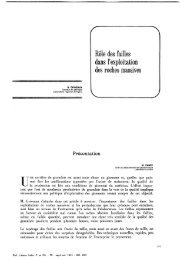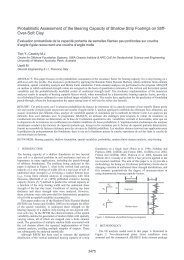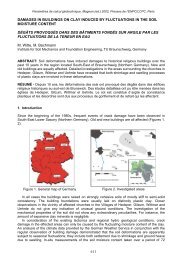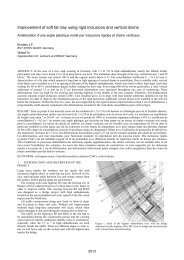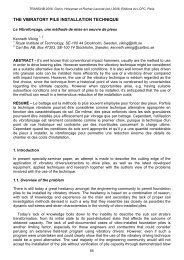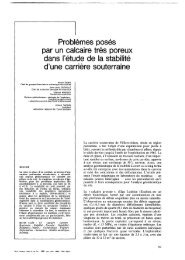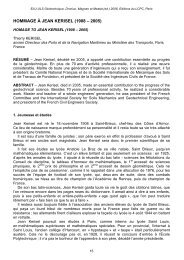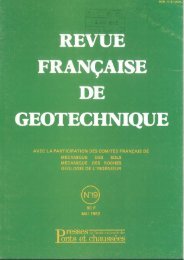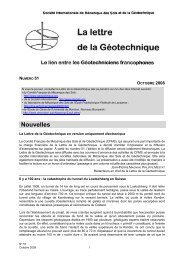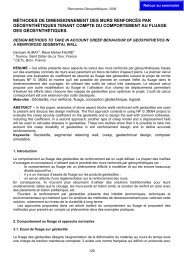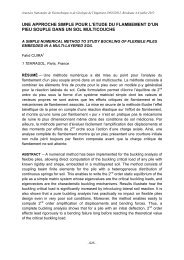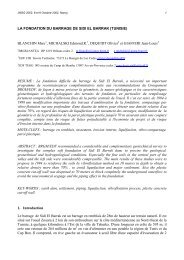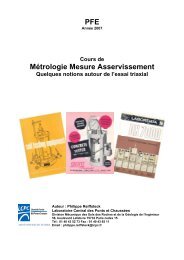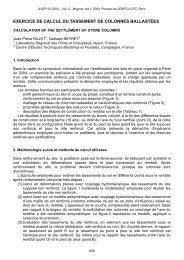Create successful ePaper yourself
Turn your PDF publications into a flip-book with our unique Google optimized e-Paper software.
<strong>Saint</strong>-<strong>Ouen</strong> limestone:<br />
its genesis an principal facies.<br />
G. CHAMPETIER DE RIBES<br />
The author begins with a brief <strong>de</strong>scription of the conditions of <strong>de</strong>posit (genesis) of<br />
<strong>Saint</strong>-<strong>Ouen</strong> limestone and the transformations (diagenesis) which have affected it in<br />
the course of geological ages. He then <strong>de</strong>fines the stratigraphie limits of <strong>Saint</strong>-<strong>Ouen</strong><br />
limestone in the Paris area, referring to the La Frette section on the banks of the<br />
Seine North of Paris. Several typical sections of this bartonian substage are then<br />
presented, with a <strong>de</strong>scription of the variations in facies observed from West to East.<br />
In conclusion, a section of <strong>Saint</strong>-<strong>Ouen</strong> limestone cannot be interpreted without a fairly<br />
thorough knowledge of the regional formation, and the geologist must always bear in<br />
mind the conditions of genesis of this <strong>de</strong>posit.<br />
Definition of the layer<br />
and some problems relating to it.<br />
B. CARON<br />
In connection with a number of highway projects and un<strong>de</strong>rground work in the Paris<br />
area, the author carried out geological surveys of sites involving <strong>Saint</strong>-<strong>Ouen</strong> limestone,<br />
and gives his views on the "complexity" of this layer and the methods which would<br />
make it possible to gain a better knowledge of it.<br />
He begins with a presentation of <strong>Saint</strong>-<strong>Ouen</strong> limestone encountered at various <strong>de</strong>pths<br />
in the subsoil of Paris and its suburbs. Then, from personal observations and from<br />
results published by specialists, he <strong>de</strong>scribes the layer and its stratigraphic, lithologic,<br />
tectonic and hydrogeological particularities in the Paris area, showing with some<br />
examples that these particularities are not distributed at random. Conclusions are<br />
drawn concerning a method of studying this geological formation in which collaboration<br />
between the geologist and the soil mechanics engineer should prove extremely fruitful.<br />
General mechanical properties<br />
Of <strong>Saint</strong>-<strong>Ouen</strong> limestone.<br />
<strong>Saint</strong>-<strong>Ouen</strong> limestone constitutes a very heterogenous layer presenting sometimes<br />
shallow alternation of lithological varieties ranging from impervious plastic marl to<br />
hard fissured rock. The layer is resistant, <strong>de</strong>spite high water content and high indices<br />
of plasticity and low cohesion.<br />
To illustrate this fact, this article gives the water content frequency curves, Atterberg<br />
limits and dry <strong>de</strong>nsities of about a hundred samples of <strong>Saint</strong>-<strong>Ouen</strong> marl. In particular,<br />
it is seen from the plasticity chart that representative points lie along a line whose<br />
s l<br />
°P e i s different from the Casagran<strong>de</strong> line test l p<br />
= 0.55 (W L<br />
- 12).<br />
Mechanical tests, rapid triaxial consolidated undrained tests, with measurement of<br />
interstitial pressure, or slow consolidated drained tests, give values of the angle of<br />
j. FLORENTIN intergranular friction f ' in the neighbourhood of 37°, whereas the values normally<br />
to be expected in soils with indices of plasticity greater than 50 are much lower;<br />
around 20°.<br />
To attempt to explain this anomaly and to discover in particular whether it may be due<br />
to a structure of the marl linked with physico-chemical phenomena, it is proposed<br />
to study, at several well-i<strong>de</strong>ntified levels of marl in the layer, the Atterberg limits<br />
before and after curing, and the shear strength characteristics of undisturbed samples<br />
and of disturbed samples of the same soils.<br />
The author was responsible for a series of bridges whose pile foundations rest on<br />
r<br />
i r . • <strong>Saint</strong>-<strong>Ouen</strong> limestone.<br />
Foundations of engineering<br />
„ 4 . . : „ +u„ ~* n», any He enumerates engineer in all similar the circumstances.<br />
problems which arose in this connection, and which will face<br />
structures in the plain of Rosny.<br />
anv enaineer in similar<br />
£ rcumstances<br />
.<br />
p. CHASSANDE T^ The e<br />
qquestions u e s t<br />
j o n s 0 of f<br />
r arate t e 0f of working, the the method of executing the foundations, and costs<br />
of the various solutions adopted are successively <strong>de</strong>alt with.<br />
114



